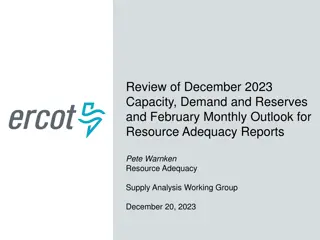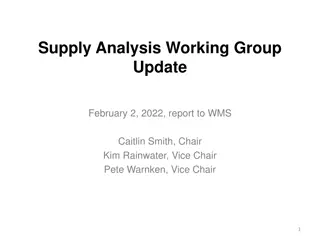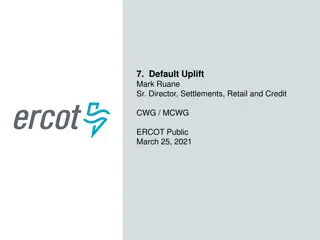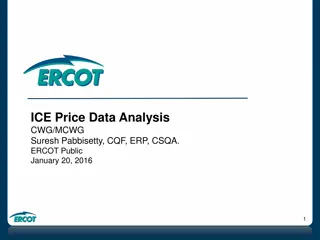ERCOT Resource Adequacy Analysis Overview
ERCOT's resource adequacy analysis involves multiple aspects such as Capacity, Demand, and Reserves Report status, NPRR submissions, ELCC definitions, and MORA tabs detailing risk assessment and historical trends. The analysis covers upcoming changes in methodologies, seasonal release schedules, and large load considerations. Monthly outlooks and mock-ups provide insights into resource capacity growth and reserve risk modeling within ERCOT's grid operations.
Download Presentation

Please find below an Image/Link to download the presentation.
The content on the website is provided AS IS for your information and personal use only. It may not be sold, licensed, or shared on other websites without obtaining consent from the author. Download presentation by click this link. If you encounter any issues during the download, it is possible that the publisher has removed the file from their server.
E N D
Presentation Transcript
CDR NPRR and MORA Status Pete Warnken Resource Adequacy Supply Analysis Working Group June 23, 2023
Status of NOPRs for the Capacity, Demand and Reserves Report ERCOT Public
NPRR Status Anticipate several NPRRs being submitted First NPRR will address Effective Load Carrying Capability as a replacement for the current Peak Average Capacity Contribution method; this is the most impactful change Slides that follow show sample NPRR language for ELCC Will include most other methodology changes Targeting submission in July 2023 Second NPRR will address seasonal release schedule and other changes that heavily depend on system implementations; targeting submission in fall 2023 A separate NPRR is currently under development that addresses Large Loads across multiple areas (registration, interconnection, operations, markets, CDR, etc.) 3 ERCOT Public
New ELCC Defined Terms: ELCC and LOLE 4 ERCOT Public
ELCC Study Requirement and Sample ELCC variables 3.2.6.2 Effective Load Carrying Capability Studies Language on the ELCC study scope, frequency, stakeholder review process, and posting on ercot.com. 5 ERCOT Public
Monthly Outlook on Resource Adequacy Mock-up ERCOT Public
MORA Tabs Summary Detailed Resource Breakdown Risk Assessment Historical trends Month-to-month resource capacity growth Year-to-year monthly comparison Previous month s actual vs forecasted demand and resources Background Purpose Definitions Probabilistic Reserve Risk Model description Monthly release schedule Mock-up sections being shown today are preliminary, and some are not shown as they are still under construction 7 ERCOT Public
Mock-up: Summary Tab, Section 1 Assuming that the ERCOT Region experiences typical grid conditions for [Month]: There should be [sufficient] | [insufficient] generating capacity available to serve the expected system-wide peak load at HH [AM]|[PM]. There should be [sufficient] | [insufficient] generating capacity available to serve the expected system-wide net peak load at HH [AM]|[ PM]. The monthly capacity reserve margin, expressed as a percentage, is XX.X%. (Reserve Margin formula: ((Total Resources / (Peak Demand - Emergency Resources)) - 1) * 100) The ratio of available dispatchable to total capacity is XX.X%. Peak Load Hour Net Peak Load Hour Expected Thermal Outages [2] Expected Thermal Outages [2] Generation Resource Stack [1] Gross Demand [3] Emergency Resources [4] CAFOR Position [5] Generation Resource Stack [1] Gross Demand [3] Emergency Resources [4] CAFOR Position [5] X,XXX MW Dispatchable XX,XXX MW X,XXX MW XX,XXX MW Dispatchable XX,XXX MW Surplus = XX,XXX MW Non-Dispatchable XX,XXX MW Non-dispatchable Deficit = XX,XXX MW XX,XXX MW XX,XXX MW < 2,500 MW > X,XXX MW X,XXX MW [1] Dispatchable resources comprise nuclear, coal, gas, biomass and energy storage. Nondispatchable resources comprise wind and solar. Dispatchable in this context means that the resource can both increase or decrease output based on ERCOT dispatch instructions. [2] Consists of both planned and unplanned outages for thermal ("fossil-fueled") generation resources. [3] Gross demand is ERCOT's official monthly peak load forecast adjusted for peak consumption at Large Flexible Load (LFL) facilities. Gross demand also accounts for incremental growth in rooftop solar facilities not captured in the historical data used for load forecasting. [4] Emergency Resources consist of Load Resources that ERCOT can deploy prior to, or during, an emergency condition. These Load Resources include distribution voltage reduction, Emergency Response Service (ERS), Load Resources that provide Responsive Reserves, and Transmission & Distribution Service Provider (TDSP) load management programs. [5] CAFOR Position is the amount of Capacity Available for Operating Reserves above (a surplus) or below (a deficit) the current EEA risk threshold of 2,500 MW. Energy Emergency Alert (EEA) Risk Assessment for [Month]: The hour with the highest probability of ERCOT declaring an EEA is HH [AM]|[PM]. The probability of declaring an EEA Level 1 is XX.X%. The probability of declaring rotating outages (EEA Level 3) is XX.X%. 8 ERCOT Public
Mock-up: Summary Tab, Section 2 Demand & Resource Availability Summary for [Month] [Year] 9 ERCOT Public
Mock-up: Detailed Resource Breakdown Tab Peak Demand Hour (Hour-ending) Peak Net Demand Hour [1] Hour-ending Installed Capacity Rating [3] Expected Available Capacity 4/ Operational Resources, MW [2] Thermal 86,437 66,466 45,840 8,652 932 11,042 71,299 52,759 34,513 6,693 922 10,631 71,299 52,759 34,513 6,693 922 10,631 Natural Gas Combined-cycle Combustion Turbine Internal Combustion Engine Steam Turbine Compressed Air Energy Storage Coal Nuclear Renewable Solar Far West West Non-West Wind Coastal Planhandle Other Hydroelectric Biomass Energy Storage, Net Discharge Batteries Other DC Tie Net Imports Planned Resources [3] Resource categories generally align with those listed in the Generator Interconnection Status (GIS) reports - - - 14,703 5,268 54,142 15,659 4,920 2,769 7,970 37,746 5,436 4,410 27,900 563 174 3,287 3,287 13,567 4,973 23,332 12,264 3,853 2,169 6,242 10,427 3,258 1,322 5,847 478 163 447 447 13,567 4,973 17,682 45 14 8 23 16,996 5,311 2,155 9,530 478 163 415 415 - - - 1,220 850 850 Thermal 720 720 539 121 - 60 - 471 471 - 320 151 - - - - 257 257 - 688 688 539 89 - 60 - 372 372 - 253 119 - - - 688 688 539 89 - 60 - Natural Gas Combined-cycle Combustion Turbine Internal Combustion Engine Steam Turbine Compressed Air Energy Storage Renewable Solar Far West West Non-West Wind Coastal Planhandle Other Energy Storage, Net Discharge Batteries Other NOTES: 1/ Net load is total load minus wind and solar generation, and represents the demand that must be met with other available resources. 2/ Operational resources are those for which ERCOT has approved grid synchronization or full commercial operations. 3/ Planned resources are those for which ERCOT expects to have approved grid synchronization or assigned a Model Ready Date" (for Small Generators) by the first of the month. 5 5 - 3 2 4/ Installed capacity ratings are based on the maximum power that a generating unit can produce during normal sustained operating conditions as specified by the equipment manufacturer. - - - - 5/ Expected Available Capacity for operational units accounts for thermal seasonal sustained capability ratings, monthly/hourly capacity contribution estimates for intermittent renewables, planned retirements, reductions due to co-located loads, unavailable Switchable Generation Resources (SWGRs), mothballed capacity, and expected Private Use Network (PUN) generator net exports to the grid. For planned projects, Expected Available Capacity is based on the maximum capacity reported by the developers and accounts for net changes due to repower or upgrade projects greater than one MW, and the established limits on the total MW Injection for designated Self-Limiting Facilities. - - - 32 32 - 146,534 96,988 90,971 Total Resources, MW 10 ERCOT Public
Mock-up: CAFOR Ranges and Probabilities, Section 1 CAFOR Range and Probability Analysis for Peak Load and Net Peak Load Hours The two tables below show probability and average risk variable values for various CAFOR ranges. The ranges are aligned with key near-EEA and EEA risk thresholds. The first table shows values for the forecasted monthly gross peak load, while the second shows the same information for the forecasted monthly net peak load hour. Hour-Ending 5 PM Extreme Event Scenario [2] Range of Capacity Available for Operating Reserves (CAFOR), MW CAFOR MW: <= -10,000 0.000% -10,000 < x <= 0 0.140% 0 < x <= 1,000 0.180% 2,300 < x <= 3,000 0.410% > 3,000 98.680% 1,000 < x <= 2,300 0.590% (1,352) 0.10% Probability of Occurrence [1] Risk Variables, Range Average MW [3] Net Peak Demand [4] Thermal Unplanned Outages Wind Production Solar Production n/a n/a n/a n/a 83,655 8,569 1,853 10,460 83,353 8,448 2,786 10,812 83,544 6,994 2,501 11,011 83,431 6,963 2,781 11,104 82,840 4,329 10,350 12,087 83,523 8,444 2,040 9,221 [1] Probabilities represent the likelihood that CAFOR is within the specified range. They are based on the number of simulation outcomes in the range divided by the total number of simulation trials (10,000). [2] The average of the worst 0.1% of simulation outcomes. [3] Risk variable values are based on the average MW values associated with the CAFOR outcomes for the specified range. [4] Net Peak Demand is the SARA "Adjusted Peak Load Forecast" less price-responsive demand reduction selected by the model. PRD ranges from 698 MW to 4,984 MW. Hour-Ending 9 PM Extreme Event Scenario [2] CAFOR MW: Range of Capacity Available for Operating Reserves (CAFOR), MW <= -10,000 0.00% -10,000 < x <= 0 8.28% 0 < x <= 1,000 3.22% 2,300 < x <= 3,000 3.25% > 3,000 80.17% 1,000 < x <= 2,300 5.08% (8,407) 0.10% Probability of Occurrence [1] Risk Variables, Range Average MW [3] Net Peak Demand [4] Thermal Unplanned Outages Wind Production Solar Production n/a n/a N/A 50 80,211 8,569 4,306 79,599 8,448 5,336 79,435 6,994 6,441 79,310 6,963 7,145 78,821 4,329 15,930 78,379 9,945 3,119 50 50 50 50 50 50 [1] Probabilities represent the likelihood that CAFOR is within the specified range. They are based on the number of simulation outcomes in the range divided by the total number of simulation trials (10,000). [2] The average of the worst 0.1% of simulation outcomes. [3] Risk variable values are based on the average MW values associated with the CAFOR outcomes for the specified range. [4] Net Peak Demand is the SARA "Adjusted Peak Load Forecast" less price-responsive demand reduction selected by the model. PRD ranges from 698 MW to 4,984 MW. 11 ERCOT Public
Mock-up: EEA Hourly Risk Profile, Section 2 The following chart shows the hourly probabilities for CAFOR being at or below EEA risk threshold levels for a peak load day in [Month] [Year] Hourly Energy Energy Alert (EEA) Risk Profile ` 12 ERCOT Public
Mock-up: Historical Trends Tab, Section 1 Prior Month Forecast vs. Actual, [Month] Hour-Ending 5 PM [Month] Forecast [Actual] Actual Difference Demand Total Resources Thermal Wind Solar Energy Storage Other CAFOR Hour-Ending 9 PM [Month] Forecast [Actual] Actual Difference Demand Total Resources Thermal Wind Solar Energy Storage Other CAFOR 13 ERCOT Public































